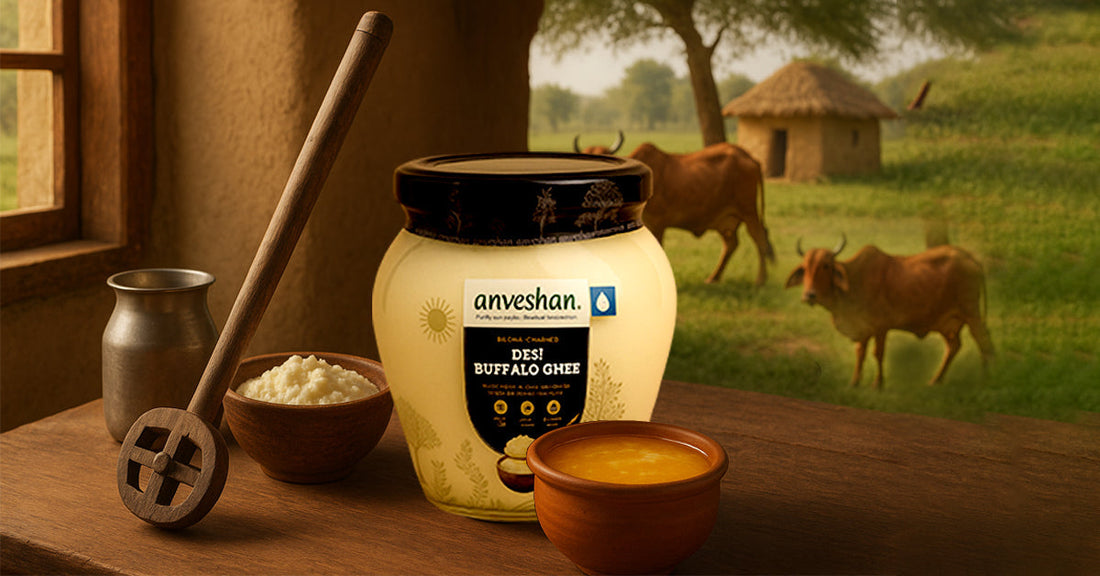
Bilona Ghee vs Commercial Ghee: Why India Trusts Tradition Again
Share
Bilona ghee is at the heart of India’s culinary and wellness revival. Known for its deep-rooted Ayurvedic value and rich nutritional profile, this traditional form of clarified butter is being rediscovered by health-conscious individuals across the country. As processed dairy products flood the market, more Indians are choosing to go back to the origins, relying on ghee made using age-old methods from desi cow milk.
What Makes Bilona Ghee Unique
Bilona ghee is not just another dairy product. It is created through a slow, deliberate process that begins with boiling raw A2 milk, setting it into curd, churning the curd into butter using a wooden bilona, and finally heating it gently over a low flame to obtain ghee. Every step preserves nutrients and enhances flavour.
Core Characteristics of Bilona Ghee:
-
Made from A2 cow milk sourced from indigenous breeds such as Gir, Sahiwal, and Hallikar
-
Prepared using the curd-churning method, not cream
-
Retains butyric acid, CLA, and fat-soluble vitamins
-
Naturally rich in aroma, texture, and medicinal properties
-
Aligned with Ayurvedic health principles
Commercial Ghee: The Industrial Shortcut
Unlike bilona ghee, commercial ghee is manufactured in bulk using industrial machines. Instead of curd, it is often made by directly heating cream separated from milk. The focus is on speed, efficiency, and cost-effectiveness.
Typical Features of Commercial Ghee:
-
Often made using A1 or mixed milk
-
Lacks the digestive and metabolic benefits of bilona ghee
-
Subject to high-heat treatment that breaks down key nutrients
-
May include added colour, flavour, or preservatives
-
Cheaper, but lower in quality and health value
Nutritional Differences: A2-Based Bilona Ghee vs Commercial Ghee
|
Feature |
Bilona Ghee |
Commercial Ghee |
|
Milk Source |
A2 desi cow milk (Gir, Sahiwal, Hallikar) |
A1 or mixed milk |
|
Method |
Curd → Butter → Ghee (Bilona method) |
Cream → Ghee (Direct heating) |
|
Nutrient Profile |
Butyric acid, CLA, vitamins A, D, E, K |
Reduced due to heat processing |
|
Digestibility |
Easy on the gut |
May cause discomfort in lactose-sensitive individuals |
|
Ayurveda Compatibility |
Strongly recommended |
Not typically used in traditional practice |
|
Flavour and Texture |
Rich, nutty, and granular |
Often flat and uniform |
Ayurvedic Viewpoint: Bilona Ghee as a Healing Food
In traditional Ayurvedic texts, bilona ghee is referred to as a nourishing and medicinal fat. It supports digestion, improves absorption of herbs, and is used as a base in therapeutic formulations. The ghee’s ability to balance all three doshas—Vata, Pitta, and Kapha—makes it a key ingredient in holistic nutrition.
Reported Benefits:
-
Enhances gut lining and immunity
-
Lubricates joints and supports bone health
-
Boosts energy and metabolic function
-
Promotes skin and cognitive health
-
Aids detoxification processes naturally
Importance of A2 Milk in Ghee Making
The use of A2 milk is critical in maintaining the traditional quality of bilona ghee. Milk from desi cows like Gir, Sahiwal, and Hallikar contains A2 beta-casein, which is known for better digestibility and reduced inflammatory response. In contrast, commercial dairy farms often use high-yielding crossbred cows producing A1 milk, which may not offer the same health benefits.
Products made from A2 milk align with natural food systems and support the body without triggering common digestive issues linked to conventional dairy.
How to Recognise Authentic Bilona Ghee
Not every product labelled as “desi ghee” follows the bilona method. Identifying the real thing requires careful observation.
Signs of True Bilona Ghee:
-
Deep yellow to golden hue
-
Pleasant nutty aroma
-
Visible grainy texture when cooled
-
Mention of curd-churning process on the label
-
Source transparency: A2 cow milk from desi breeds like Hallikar, Gir, or Sahiwal
Packaging should clearly state “bilona method” and “A2 milk” to ensure it meets traditional standards.
Consumer Shift: Why Bilona Ghee Is in Demand Again
Health awareness has transformed how people choose everyday ingredients. With more attention on gut health, immune resilience, and clean nutrition, bilona ghee has emerged as a preferred fat source. This resurgence is powered by the need for authenticity in food, free from artificial processing and full of functional benefits.
Rural producers and ethical farms now offer bilona ghee made using sustainable practices, giving consumers access to purity without compromising modern convenience.












 You saved ₹-48 on this order
You saved ₹-48 on this order
